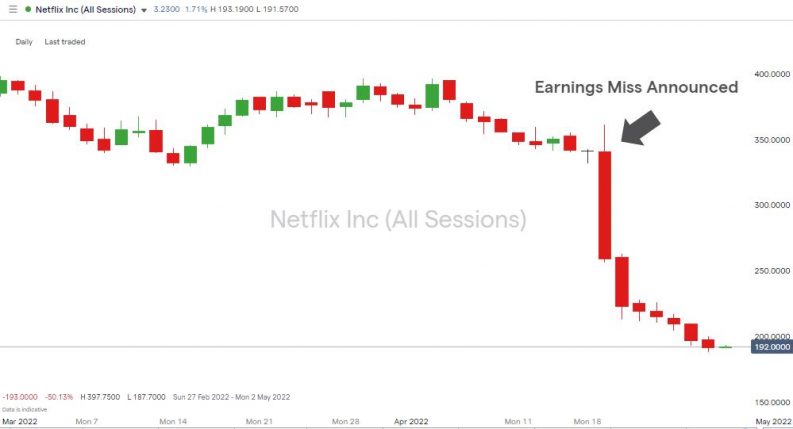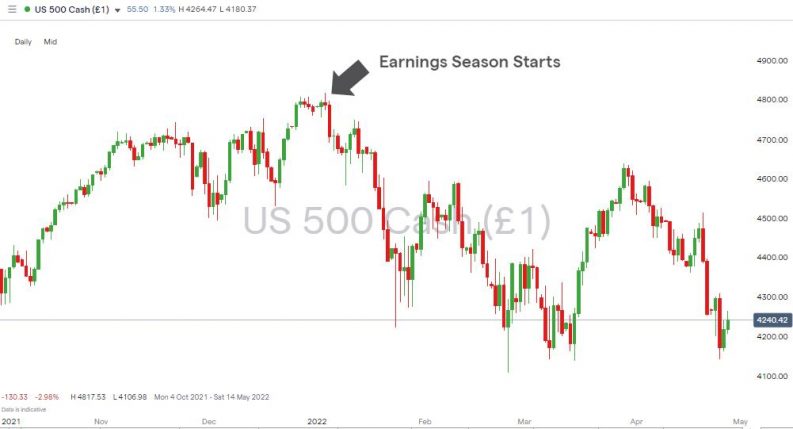
The importance of earnings season can’t be downplayed. It forms the foundation of the decision-making processes of those who use fundamental analysis. Digging into the details of what is involved and what can be expected can help investors optimise their trading decisions.
What is earnings season?
Earnings season is the window of time in which publicly listed corporations release their earnings reports to the public. At the same time, they will update investors on key metrics such as revenues, costs, debt write-offs and dividend payments. One of the most commonly used measures of performance is earnings per share (EPS).
Announcements also include guidance on the next quarter’s outlook, which means earnings releases can make-or-break market sentiment. The news releases typically start trickling onto the newswires one or two weeks after the end of each financial quarter. As most of the big names release data within the following six weeks, the second half of January, April, July and October are periods when a heap of crucial signals regarding future stock moves can be identified.
There’s no official start or end to earnings season and some firms that have quarter ends on months other than March, June, September, or December will make their earnings releases at different time points compared to most of the market.
US firms listed on the major exchanges are obliged by the Securities and Exchange Commission (SEC) to share quarterly earnings called 10-Q reports within 45 days of the end of their financial quarter. More comprehensive annual statements, 10-Ks must be released within 90 days of the company’s financial year-end.
Companies often schedule an earnings call between company management analysts, institutional investors and shareholders. Earnings calls allow companies to present more detail on the previous quarter’s performance and provide a question and answer session for investors. Calls must comply with Fair Disclosure, Regulation FD guidelines, which are meant to ensure that smaller investors have the same access to information as larger ones.
Key dates to look out for during earnings season
The start of the season was traditionally marked by the publication of data by aluminium producer Alcoa (AA). Big banks such as JP Morgan, Citigroup, Bank of America and Wells Fargo are not far behind, with analysts reading into the fortunes of the financial giants for clues about the state of the economy.
Certain corporations have a track record of releasing their earnings on the same day. Whether this is by accident or design, these days can be preceded by cautious side-ways trading as investors brace themselves. The Q1 earnings of 2022 saw tech giants Meta (Facebook), Amazon, Spotify and PayPal all release their updates on the same day, 28th April 2022.
Earnings releases are so important to stock prices that they are made after the US stock exchanges, the NASDAQ and New York Stock Exchange have ceased trading for the day. This is to allow investors time to dig into granular detail before the market re-opens, and also builds in a cooling-off period so that decisions to buy or sell stocks aren’t made in the heat of the moment.
If actual earnings are better than predictions, known as an earnings ‘beat’, then a price surge can be expected when the market reopens. Worse than expected numbers, known as an earnings ‘miss’, is likely to be followed by a tough trading session for existing shareholders but a chance to buy the dip for dip-buyers.
An added layer of confusion is introduced by the fact that the reports are quite detailed. Some elements of the report, for example, earnings, may be a beat, but earnings, after costs have been deducted, might be a miss.
Stock specific earnings price changes – Netflix case study
The Q1 2022 earnings for Netflix caused the NFLX stock price to crater. The share price fell more than 25% on the day of the announcement. One week later, Netflix stock had given up almost half of its value compared to pre-earnings prices.
Netflix – Daily Price Chart – April 2022 – Big earnings miss

Source: IG
In this instance, the problems were stock specific. Investors were particularly spooked by the streaming service reporting its first fall in subscriber numbers in more than a decade, with 200,000 customers having cancelled their contracts during January, February and March.
Digging into the details of the subscriber numbers unearths the tricky balance between analyst forecasts, company guidance and reality. Market analysts had forecast that instead of falling in Q1, that subscriber numbers would rise by 2.7 million. The firm itself had offered guidance that a more conservative 2.5 million new users could be expected to sign up. The reality was a horror show for investors and was matched by understatements from the Netflix management, which included: “Our revenue growth has slowed considerably” (Source: MarketWatch).
Netflix’s problems were alarming news for the tech sector, but there was no clear indication that the peer group would suffer the same fate. Rival Disney is traditionally a late-comer to the earnings party and its earnings release date of 11th May 2022 left investors wondering if Disney would also disappoint or if it had even picked up market share from its rival.
Other firms are seen as providing insight into the broader market and these bellwether stocks attract a lot of attention.
The big banks, which often report in the first week of the season, offer a slightly detached impression of how the economy is performing. This appetiser to the earnings season is again often associated with firms making announcements on the same date. During the Q1 earnings season of 2022, Goldman Sachs, Morgan Stanley, Wells Fargo and Citigroup all released earnings on 14th April.
What to look out for during earnings season
There are some features of the earnings season that are worth looking out for each time it comes around. The release of data follows a typical pattern and trading strategies begin to come into play during the build-up to earnings season.
With so much riding on the upcoming announcements, the week before earnings season kicks off can be a tense one for investors. Each season is different, but traders would do well to establish if price volatility is picking up as investors are making their decisions early, or if price is moving sideways as the market holds off on making a call.
Day traders, in particular, will have earnings season pencilled into their calendars as the build-up presents opportunities to use short-term strategies based on momentum or range-bound price action.
Another characteristic of earnings season is an uptick in trading volumes. This means the period forms a sweet spot for day traders. Increased trade volumes after any earnings announcement provide the perfect conditions for scalping strategies because traders can get into and out of positions cost-effectively.
It’s also possible for surprise announcements to cause stock market news to rank more highly in the mainstream media. This can act as a catalyst for newbies to get involved in making a return from the markets. Not only are stocks potentially in the headlines, but the earnings announcement acts as a form of ‘reset’ for stock prices, so new investors can feel they’re opening positions at a logical stage of the financial calendar.
The details released in earnings announcements can help investors reappraise their perception of a particular stock. For example, an unexpected cut in the dividend rate can result in a stock being recategorised and moved out of the high-yield stock category. An announcement that a firm is embarking on an expansion policy into new markets or products can see it shift from being a defensive stock into a growth stock. Such events can mark the start of new long-term trends forming as investors with different risk appetites rotate into or out of a particular stock,
One anomaly of earnings season is that positive earnings data does not always equate to higher share prices. The EPS of a firm is derived from historical data and is a glance in the rear-view mirror rather than a guarantee of a firm’s future prospects. The guidance offered by management in terms of future expansion plans or dividend pay-outs can be more influential in terms of where a stock heads next.
S&P 500 Index Q1 2022 – Daily Price Chart – Market falls after upbeat earnings

Source: IG
There can also be ‘red flags’ for investors during earnings season. One of the potential hazards to look out for are firms that delay their earnings release. This can be down to operational issues, but delayed earnings announcements tend to contain bad news.
Why do so many firms ‘beat’ analyst expectations?
Market data experts Refinitiv keep a close eye on earnings season data. They have established the market has a bias towards ‘earnings beats’ and calculate that since 1994 the actual earnings of firms have, on average, been 3.6% higher than the forecast numbers of industry analysts. They also report that on average 65% of firms beat their forecast. Some years, the number of ‘beats’ is even higher and can result in a sense of euphoria gripping the markets.
Establishing why analyst forecasts are so often beaten involves a degree of guesswork relating to human psychology. One cause could be that analysts missed something. Another is that they feel they’ll look less impulsive if they underestimate rather than overestimate the potential of a stock, but there is more to the situation than that.
Analyst reports on firms aren’t ‘real-time’, at least not for the general public. If a big corporation such as Microsoft releases mid-quarter updates on its prospects, the analysts at the big investment banks will consider the information but not necessarily update their published forecasts. The reality is that clients are much more important to the analyst and will be demanding of their time. The price targets and ratings of the stock may change, but it is the paying clients who will be first to find that out.
Public notifications of re-ratings of firms occur intermittently and after important clients have had a chance to digest the news and adjust their positions accordingly. As a result, there can be a mismatch between published forecasts and the official earnings report. How important is this? Well, very. The Chicago Booth School of Business investigated the benefits that paying clients of investment banks might have over the rest of the investor community.
“Researchers demonstrate that a simple strategy based on buying companies expected to beat earnings, using share price target revisions and the text of reports, yields significant abnormal returns, suggesting the [rest of the] market does not see through the analysts’ strategy for conveying information selectively.”
Source: Chicago Booth
The importance of research
It’s important to stress that analysts and their clients aren’t doing anything which contravenes market rules and regulations. The clients of the big banks pay considerable fees to be able to access the research of analysts, which is based on publicly available information. It just represents division of labour in the economy.
Possibly a more important lesson it offers is that it is crucial to carry out research and keep up to date with events which might impact your portfolio. Good brokers can help with that and while our shortlist of trusted brokers includes names that are well-regulated and offer cost-effective trading, some do specialise in providing their clients with news in different formats, including email, text alerts, daily market reports and even online TV.
The markets behave differently during earnings season. The abundance of important news updates, some of which have far-reaching effects, can create increased short-term price volatility. It’s important to accept that surprises could be in store and reappraise your own investment objectives.
As earnings season approaches, it is important to be aware of your investment aims. The increase in trading activity can be of benefit to day traders and others who run short-term strategies. Investors with a longer investment time horizon may take a different approach and simply acknowledge the change in market conditions and ride out the short-term noise.
It’s also important to keep an eye on the ‘bigger picture’. Earnings season does reveal clues to the direction the economy is taking and that might bring about a change in strategy. This can result in the financial markets as a whole moving in a way that reflects a broad change in risk appetite. This makes preparing for earnings season crucial. This might take the form of reducing the size of your portfolio, so you have spare cash to step in and buy should you want to. It is also likely that new events will need to be more closely followed. It is also worth considering the risk of a market correction being triggered. This report on what to do when markets sell off is a timely read as each season approaches.
Final thoughts
It’s hard to make a call on what surprises will be revealed during earnings season but entering the period in a prepared state is highly advisable. It’s also a time to make a note of when any companies you hold stocks in are releasing their numbers.
Portfolio management also needs to be considered. Reducing position size and freeing up spare capital could help you pick up a stock at a bargain price. Good brokers offer earnings season calendars, predictions and updates on market reaction. Head to this list of trusted brokers to see how different platforms offer different kinds of support. After you’ve picked the best fit for you, setting up an account takes minutes to do, and you’ll then be in the best position to start trading earnings season.
